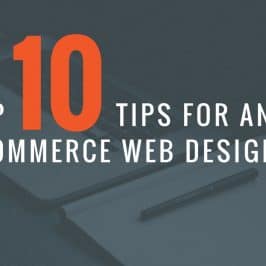Top 10 Tips for an Effective E-commerce Web Design

Designing for Success: eCommerce Websites in NZ
eCommerce has become commonplace these days, with Kiwi companies ranging from local grocery delivery services (like Countdown online) to large nationwide chains (such as The Warehouse) offering products online. Whether it’s physical items or services being sold, the reality is that customers increasingly prefer the convenience of placing orders online.
A well-designed website can significantly influence a customer’s perception of your business. It’s crucial to project a professional and reliable image (building online reputation is key) while still being interesting and creative with your design.
10 Top Tips for Effective eCommerce Web Design in New Zealand
If you’re designing the perfect website for your online business, keep these essentials in mind. Here are 10 of the best tips for creating effective eCommerce web design:
- Balance your visuals: While graphics and photos are great for adding interest, remember not to overdo it! Too many large elements can slow down your site.
- Choose backgrounds wisely: Keep a simple, neutral-coloured background if your content is image-heavy. Use background graphics or colours strategically if the page is mostly text to enhance readability without distraction.
- Ensure quality content: Make sure all information provided is well-written, with no grammatical or factual errors. Accuracy builds trust.
- Focus on product/service details: Provide comprehensive information about the products or services you offer – this is what the customer is actually there for!
- Include an FAQ page: If feasible, create an FAQ (Frequently Asked Questions) page to provide answers to common queries potential customers might have. This fits within web design best practices for user support.
- Provide clear contact information: Make sure you have a contact page so visitors can easily email or call with any specific questions.
- Use secure payment gateways: Ensure you have robust and secure payment processing set up. Customers need assurance that their financial information is safe, adhering to standards like PCI DSS.
- Encourage feedback and reviews: Invite visitors to review products or leave feedback on your site. This provides valuable insights and builds social proof, contributing positively to your online reputation.
- Integrate social media: Include links to your profiles on Facebook, Twitter, Instagram, and other relevant social media sites. This leverages their inherent marketing tools and helps expand your customer base – check out our social media marketing tips.
- Be Creative: Don’t just follow the standard template. Think about unique and interesting ways to present your products and company. Look for inspiration on sites like Awwwards, but always prioritise usability.
Getting Professional Help with Your eCommerce Design
If you’re unsure how to tackle this yourself, you could hire a professional designer. While the term “budget web design” is sometimes used, it’s more about finding value. Many designers and agencies offer services at various price points (understanding charge rates can help). Investing in professional services can ensure you get a top-quality, effective eCommerce website tailored to your business needs.